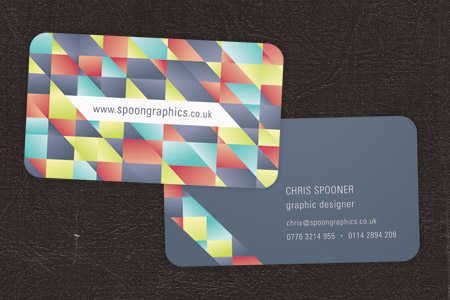Blog.SpoonGraphics | Latest Blog Entry |
| How To Design a Print Ready Die-Cut Business Card Posted: 24 Oct 2011 12:00 AM PDT Need a new set of business cards? Follow this step by step tutorial to create a cool business card design in Adobe Illustrator. We’ll begin creating the vibrant pattern effect, then we’ll lay out the contact information and set up the final print ready file ready for sending off to your chosen print firm. The business card design we’ll be creating as part of this tutorial features a vibrant pattern on the rear of the card, with a minimal design on the front allowing the contact information to stand out. The final printed card will be die-cut with round corners, so we’ll set up the print ready file appropriately with the correct dimensions, bleed and margins. View the final die-cut business card design
Open up Adobe Illustrator and create a new document. I’m using UPrinting for this business card design, so I’ll use their dimensions of 3.5″ by 2″ with 0.125″ of bleed. This deign will be double sided, so enter 2 in the Number of Artboards setting.
Draw a white rectangle across the whole of the first artboard, including the red bleed outline. Use the Line tool to begin drawing intersecting lines both horizontally and vertically.
Add more intersecting lines to the design, this time diagonally by holding down the Shift key.
Select all the intersecting lines and convert them into a Compound Path by selecting the menu option or hitting CMD+8.
Add the white rectangle to the selection, then click the Divide option from the Pathfinder palette.
Right click and select Ungroup, then draw a selection across the linework beyond the edges of the document to delete them.
Set out a colourful colour scheme for your design (this one’s from ColourLovers), then begin filling random shapes with the first colour from the palette.
Continue cycling through the colours to fill the empty shapes with swatches from the palette.
Make a duplicate of the colour swatches and create vibrant gradients from the base colour to a lighter tone.
Use the Magic Wand tool to select all the shapes with the first colour from the palette, then use the Eyedropper tool to replace the flat colour fill with the new gradient.
Once all the shapes have gradient fills applied, zoom in and use the Gradient Tool to alter the direction of the gradient randomly for each shape.
The random fills and alternating directions of the gradients creates a really cool pattern effect to fill up the rear of the card.
Toggle on Smart Guides then use the Pen tool to fill a selection in the centre of the card to allow space for a website URL.
Enter the address of your website in your favourite font, then adjust the sizing slightly to lower the prominence of the prefix and suffix. Give it a fill using the darkest colour from your palette.
Select the text element and its surrounding shape, then give the shape an extra click to select it as the key object. Use the Align tool to centre the text to its container.
Grab the Rounded Rectangle tool and click on the artboard to enter specific dimensions. Enter 2.5″ by 2″ with a 0.25″ radius.
Right click on the newly created rectangle and select the Create Guides option. This will create a guideline to give an insight into how the card will be cropped down during printing.
With the front of the card complete it’s time to move onto the rear. Fill a rectangle covering the second artboard with a swatch from the colour palette.
Select and copy a series of vibrant shapes from the front of the card and position them on the rear to continue the pattern. Position these shapes running across the lower left of the card.
In the remaining white space use the Text tool to enter your name, job title and contact details using the typeface of your choice. Give certain text elements more visual prominence by altering its case and size.
The two contact telephone numbers are laid out side by side, so draw a small bullet with the circle tool to separate them.
Align the text elements, then move them exactly into the lower right corner. Hold the Shift key then move the text elements back into their own space.
The overall design of the business card is complete, now let’s prepare the file for print. First select all and convert all text elements to outlines to avoid any font related problems with your printer.
Go to File > Save As and select the PDF option. In the settings alter the preset to Press Quality then alter the standard to whatever is recommended by your printer. In this case it’s PDF/X-1a:2001. You also have the options of adding crop marks, but in this case they aren’t necessary so just the Use Document Bleed Settings option is checked. Your print ready business card design is ready for sending off to your printer of choice. When they arrive in the post you’ll see the final product cropped to size according to the dimensions set in your print file. |
| You are subscribed to email updates from Blog.SpoonGraphics To stop receiving these emails, you may unsubscribe now. | Email delivery powered by Google |
| Google Inc., 20 West Kinzie, Chicago IL USA 60610 | |



























Aucun commentaire:
Enregistrer un commentaire